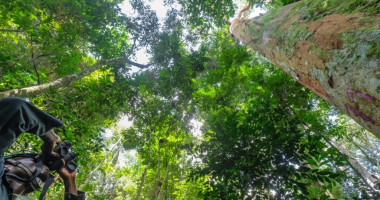Rebooting Tropical/Subtropical Agriculture (Research Outputs and Pilot Project) ( lemmy.world )
{"Location":{"Latitude":"4.6125522","Longitude":"13.1535811"},"Category":"Partners","Type":"Regeneration Agriculture","Status_Of_The_Project":"closed","BasicData":{"Name_Of_Org":"World Agroforestry","Country":"Cameroon","Region":"Cameroon","Primary_Conservation_Action":"REFORM Agriculture","Secondary_Conservation_Action":"PROTECT Nature & Wild Habitat","Solution_Website":"https://www.cifor-icraf.org/our-work/","Organization_Website":"https://www.worldagroforestry.org/","Support_Link":"https://www.cifor-icraf.org/our-work/"},"AdditionalInfo":{"Species_Focus":"","Lessons_Learned":"The most important lesson has been the huge importance of a grassroots, participatory process in order to achieve ‘buy-in’ and success. The self-help philosophy is dependent on the farmers having a highly personal incentive to engage with the programme. Advice is “keep it simple, appropriate to the needs of the community, based on local knowledge – and encourage the villagers to do what is good for their own situation”.","Impact_Numbers":"","Impact_Tracks":"Frontline Communities","Project_Start_Date":"","Project_End_Date":"","Project_Value":"closed"},"ContactInfo":{"Contact_Person":"Roger Leakey","Email":"info@cifor-icraf.org"},"Description":{"Organization_Mission_Statement":"To generate science-based knowledge about the diverse benefits – both direct and indirect – of agroforestry, or trees in farming systems and landscapes, and to disseminate this knowledge to develop policy options and promote policies and practices that improve livelihoods and benefit the environment.","Problem_Statement":"1. Many of the problems arising from subsistence agriculture are the consequence of inappropriate International agricultural policies to address hunger and malnutrition in the tropics and sub-tropics. Typically, these policies have promoted land clearance and the intensification of farming systems using monocultures and the application of high inputs of manufactured inorganic fertilizers, pesticides etc. These costly practices are not appropriate for subsistence farmers with only about 2ha of land and an income of only US$2 per day.\n2. Typically, the result of this conventional approach to agriculture is the clearance of a new area of forest or woodland, deforestation and land degradation, characterized by the breakdown of ecological functions and the breakdown of society norms including the trafficking of wildlife, etc.\n3. The resulting agroecosystem dysfunction increases the risk of new zoonotic diseases due to the increased interface between people and wildlife.","Support_Needed":"","Activities_To_Solve_The_Problem":"","Description_Of_Solution":"An adoptable and successful 3-step approach to reverse the negative impacts of subsistence farming and to meet the needs of the farmers has been developed, tried and tested in Cameroon. It uses: (i) leguminous shrub species like Sesbania sesban and Calliandra calothyrus at about 20,000 plants per ha. This restores soil nitrogen, organic matter and initiates a functioning and much more productive agroecosystem (eg. 3-fold higher cereal crop yields); (ii) culturally-important, indigenous food and medicinal trees like Dacryodes edulis (Safou), and Irvingia gabonensis (Bush mango) to diversify the farming system. These are selected for their high quality and marketable fruits/nuts and simply propagated by cuttings to create elite cultivars. This diversification of the agroecosystem increases its sustainability; (iii) simple post-harvest processing of the tree products for wider and year-round marketing. The income generated from this can then be used to purchase inputs to further increase food crop yields. \nThe elements of the solution are to: (a) restore soil fertility and ecological health at virtually zero cost, e.g., without use of inorganic fertilizers and pesticides; (b) generate new sources of income for subsistence households; (c) community-based farmer training and capacity building in agroforestry and simple horticulture techniques.","Result_And_Outcome":"Typically, 10-30 people are trained per village. Subsequently, the skills are disseminated by word of mouth to neighbouring villages as they set up satellite village nurseries for trees and crops.\nOutcomes and impact have been recorded by farmer interviews and surveys. They include: improved soil fertility and health; reduced hunger and malnutrition; increased income and improved livelihoods; and increased biodiversity and carbon sequestration – as published in the science literature. This has transformed the lives of the participating communities, improved agroecosystem functions and restored local level biodiversity in farming systems. In addition, rural communities have developed new local businesses creating employment and improved local infrastructure."}}
